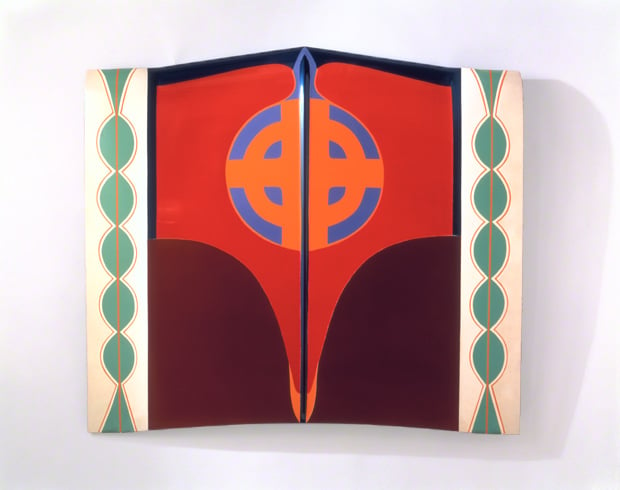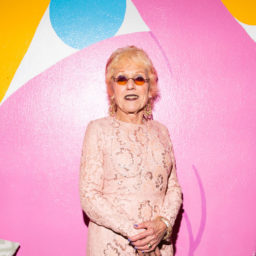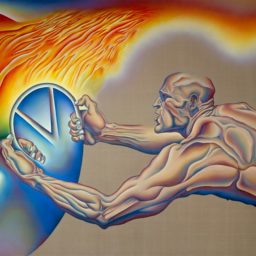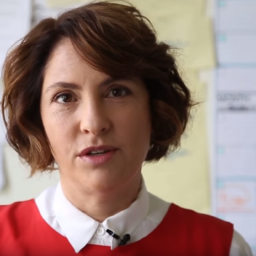For decades, Judy Chicago has aimed to prove that she is much more than The Dinner Party. This winter in Miami, viewers will get a deeper look at just how much more there is to know.
The Institute of Contemporary Art Miami has announced plans to host a survey exhibition featuring pioneering feminist artist Judy Chicago, opening in early December, just in time for Art Basel in Miami Beach.
The exhibition homes in on six major bodies of work dating from the 1960s to the ’90s, including Chicago’s early feminist work and test plates created for The Dinner Party, her masterwork, on permanent view at the Brooklyn Museum.
“We think of it kind of as a periodic survey,” Alex Gartenfield, the museum’s newly promoted artistic director, told artnet News. “It’s not encyclopedic, nor could it be exhaustive, of how prolific Judy is.”
For the artist, this is an important opportunity to showcase the breadth of her career, which has too often been eclipsed by her single, landmark work. “For many years, as gratified as I am for all the attention The Dinner Party garnered, it also blocked out the rest of my prodigious body of art,” she told artnet News in an email. “Slowly, other aspects of my production are beginning to be seen around the world, which I am thrilled about.”
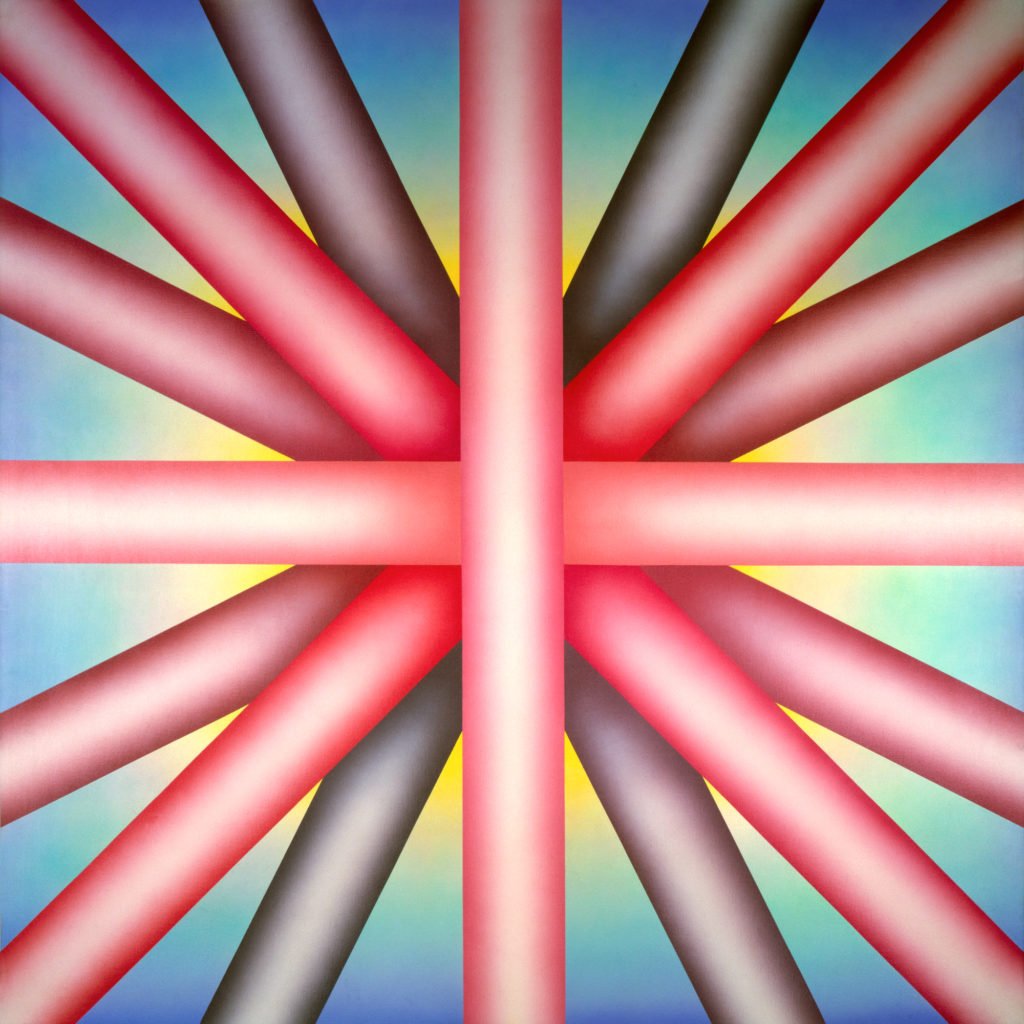
Judy Chicago, Heaven is for White Men Only (1973). Courtesy of the artist.
Gartenfeld, who is organizing the exhibition with associate curator Stephanie Seidel, has visited Chicago at her home in Belen, New Mexico, several times for this show, which he described as “a long time coming.”
“Going to the studio and spending time with the artist, you realize there’s a profound body of work that has been marginalized or underrepresented in a major institutional context,” Gartenfeld said. (Chicago is still not represented, for instance, in the collection of New York’s Museum of Modern Art.)
The artist’s major outings in the US have largely been in regional museums focusing on specific parts of her oeuvre. “There have not been major institutional shows that seek to make sense of and trace the connections between the major bodies of work,” Gartenfeld pointed out. “We’re showing work that hasn’t been shown in decades in a public context.”
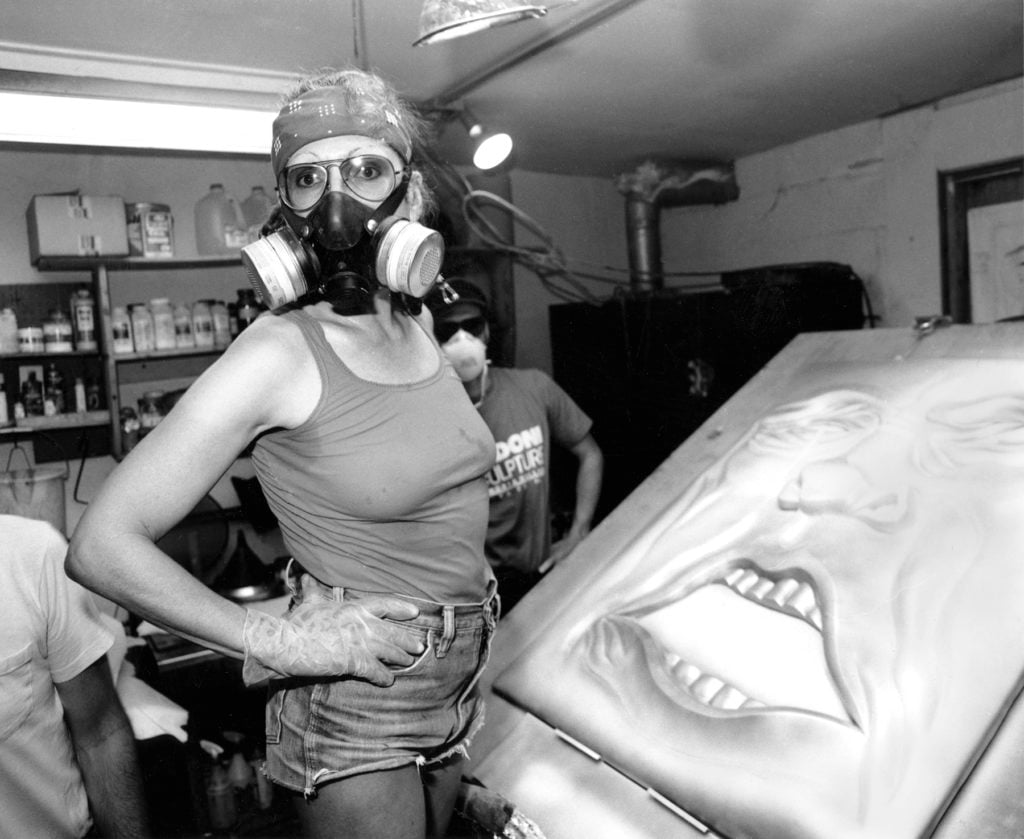
Judy Chicago working on her “PowerPlay” series at Shidoni Foundary in Santa Fe in 1986. Photo courtesy of Salon 94.
He believes that Chicago’s overlooked work is as vital as ever in 2018. “The directness and the centrality of the female voice and the feminist position within her work clearly speaks to what is going on today,” he said. “Within the context of #metoo and the broader political conversation about the representation of women in society, Judy’s work feels especially pointed today…That’s why she’s one of TIME’s 100 most influential people—because she has the ability to and the drive to communicate a set of values that are important now as much as ever, if not more.”
The upcoming show starts with Chicago’s early Minimalist works, some of which had to be refabricated for the exhibition—with limited storage space and a lack of collectors, the artist had to destroy some of her largest early sculptures. Among those being recreated for the upcoming exhibition is Sunset Squares. “It’s four squares in pastel colors that are queering or critiquing the traditional coloration of Minimalist sculpture,” Gartenfeld said.
As a young artist, Chicago felt pressure to excise all signs of femininity from her work, in order to compete with her male peers. “The biggest compliment was to be told that you painted like a man,” she told artnet News earlier this year. Fortunately for the course of art history, she ultimately chose to embrace her identity as a woman, and her work was all the stronger for it.
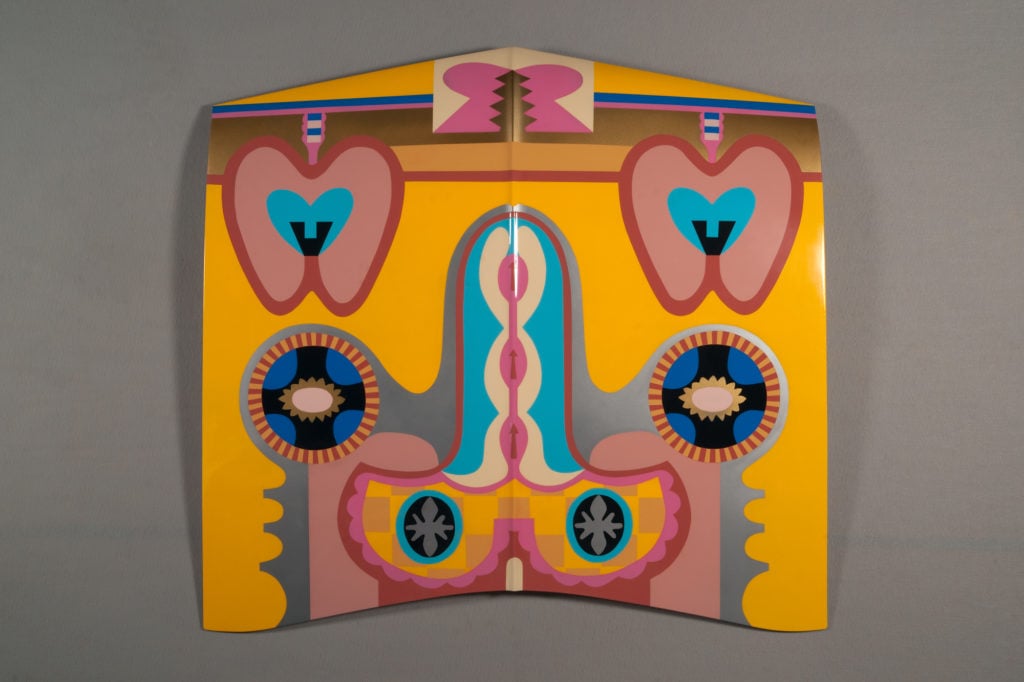
Judy Chicago, Bigamy Hood (1965, 2011). Photo courtesy of the artist.
Take her 1960s “Car Hood” sculptures, created using automotive paint on steel car hoods. “Cars are one of the most macho symbols of American culture,” Gartenfeld said. But in the “Car Hood” pieces, which hang on the walls like paintings, Chicago “introduced what would become an important figurative/abstract style in her work, in which semi-phallic and vaginal forms are converging.”
Next up are the artist’s early feminist works, which Gartenfeld described as “paintings executed in kind of a spray finish gradient style, following her experience with the car hoods—but dedicated to great ladies of literature and culture.”
Then, in the wake of The Dinner Party—a massively ambitious project that saw Chicago embrace a slew of traditionally feminine artistic practices such as needlepoint, embroidery, and ceramic painting—came “The Birth Project.”
“Judy was thinking, as she tends to do, about art history and the canon,” Gartenfeld said. “She realized that there are an endless number of female nudes and carnal scenes in art history but there are no scenes of a woman bearing a child…So much of Judy’s work is about giving form to important phenomena that are central to the female experience and have been underrepresented art historically.”
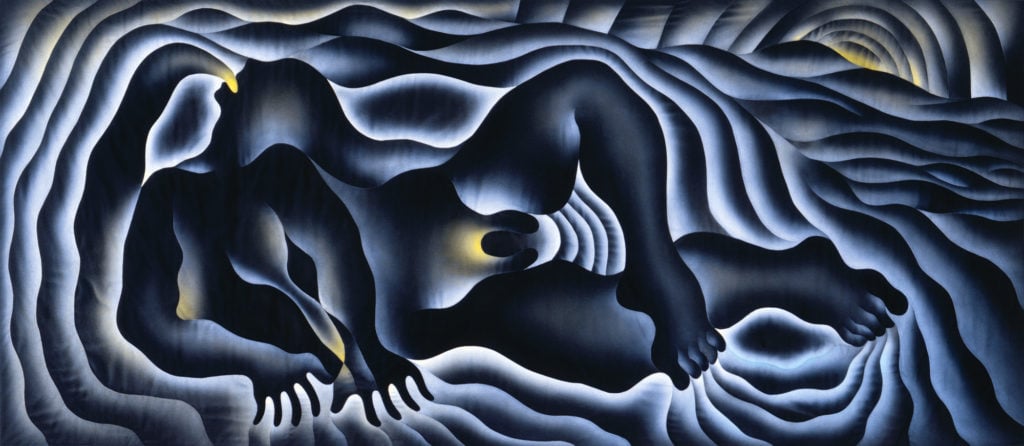
Judy Chicago, Earth Birth (1983). Courtesy of the artist.
Drawing on her experiences with The Dinner Party, which required a veritable army of volunteers with expertise in so-called crafting practices, Chicago enlisted professionals in the textile arts to help produce “The Birth Project” tapestries.
The resulting works “champion the centrality of birth within human experience,” Gartenfeld added. “They demonstrate Judy’s real appetite for taking on new crafts, and also the spirit of collaboration that is a big part of her work.”
The last major body of work included is “Autobiography of a Year,” some 150 works on paper the artist created in following the harsh critical reception for “The Holocaust Project,” an eight-year-long effort that explored her Jewish identity and her own journey to better understand the genocide. Gartenfeld described the series as “Judy’s response to the experience of creating a body of work that was so radically rejected for being too involved with identity.”
“It hasn’t been exhibited often and shows a very different and more personal side of my practice,” Chicago said.
There will also be three monumental paintings from the “PowerPlay” series from the late ’80s, the subject of the artist’s recent exhibition at Salon 94 in New York, which confront the masculine ego.
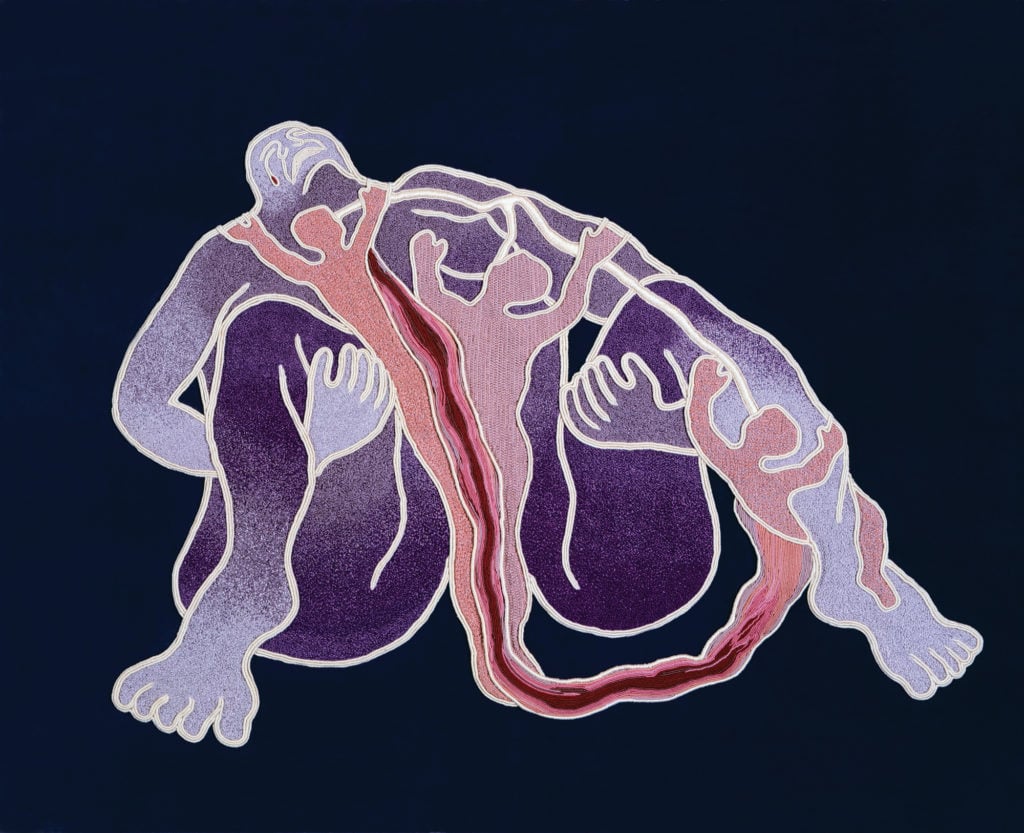
Judy Chicago, Birth Tear_Tear (1984). Photo courtesy the artist.
“The first time I met Judy, she gave me almost an art history lesson about the way that her work developed and fit into or didn’t fit into mainstream and popular contemporary art history and culture over the last 40, 50 years,” he added. “The history books are written by people, not by God. She really sees it as part of her role to make sure that history is written more equitably than it has been in the past, to inspire generations of female practitioners, not to mention other classes who have been historically marginalized.”
Aside from these lofty goals, Chicago is simply excited for the opportunity to show so many different pieces from across her career at the same time. “Audiences will be exposed to a lot of unfamiliar work,” the artist said, pointing out that she is creating a new, site-specific fireworks piece for the occasion. “I hope they will be amazed.”
“Judy Chicago: A Reckoning” is on view at the ICA Miami, 61 NE 41st Street, Miami, December 4, 2018–February 24, 2019.
